Pakistan faces significant vulnerability to climate change, experiencing disasters such as rain-fed flash floods, Glacier Lake Outburst Floods (GLOF), and more recently, extreme heatwaves and wildfires. According to Global Forest Watch (globalforestwatch.org), fires were responsible for 55% of tree cover loss in Pakistan between 2001 and 2023. The Forest Fire Detection and Early Warning System (FFD-EWS), developed by LUMS in collaboration with WWF-Pakistan and the Khyber Pakhtunkhwa (KPK) Forest Department, represents a groundbreaking innovation for climate change resilience. This unique system integrates AI-powered real-time IoT cameras, remote sensing, and predictive modeling for a cost-effective and scalable solution tailored to Pakistan's infrastructure. Our project addresses the critical issue of forest fires threatening the vital forests of KPK. Traditional methods of fire detection and response have proven insufficient, often leading to devastating losses. The FFD-EWS revolutionises this process by providing timely alerts and comprehensive fire risk maps, enabling efficient responses that reduce safety risks for firefighting teams and minimise environmental damage. One of the most remarkable aspects of our project is its multifaceted approach to disaster management, encompassing preparedness, alertness, and response. By building the capacity of government agencies and bridging knowledge gaps, the FFD-EWS supports data-driven policymaking and sustainable management of natural resources. Our system's scalability and interoperability ensure its expansion to address other climate change-related vulnerabilities such as flash floods, landslides, deforestation monitoring, biodiversity monitoring, and human-wildlife conflict prevention. The FFD-EWS stands out as a pioneering initiative that combines cutting-edge technology with local expertise to create a resilient and sustainable environmental management system.

RUNNER-UP
Impactful Research Team of the Year Award
Low-Cost Early Warning System for Forest Fires
RUNNER-UP Impactful Research Team of the Year Award
Peoples' Choice Category Winner
PI Organisation: Lahore University of Management Sciences Collaborating Organisation: WWF Pakistan Stakeholder: KPK Forest Department - Pakistan
"High-impact Low-Cost Technology Solutions for Climate Change"

Engage on social media
(Centre for Water Informatics and Technology Official LinkedIn handle)
(Official Technology for People Initiative, LUMS Facebook account)
(Centre for Water Informatics and Technology Official Facebook handle)
Summary
Key People

Dr. Murtaza Taj
Associate Professor and Co-PI of NCRA-Agricultural Robotics Lab
Department of Computer Science,
LUMS

Dr. Mian Muhammad Awais
Associate Professor and Co-PI of NCRA-Agricultural Robotics Lab
Department of Computer Science,
LUMS

Dr. Abubakr Muhammad
Director, and PI of NCRA-Agricultural Robotics Lab
Centre for Water Informatics and Technology,
LUMS

Ali Akbar Abbas
Business Development Manager
Centre for Water Informatics and Technology,
LUMS

Muhammad Waseem
Regional Head Khyber Pakhtunkhwa/Senior Manager Conservation & NbS
WWF - Pakistan
Acknowledgements
We acknowledge the invaluable support of the UK Foreign Commonwealth and Development Office (FCDO). Their funding and guidance have been critical in driving our project forward and ensuring its successful implementation.
We also extend our sincere thanks to DT Global and Brink for their ongoing involvement and expertise in project and innovation management.
Images
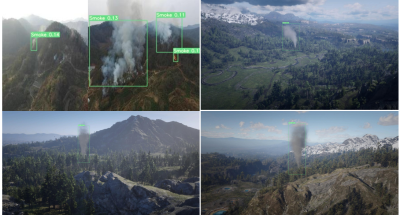
AI Model Training for Forest Fire Detection: This collage shows synthetic datasets created using game engine simulations due to a lack of sufficient real-world data. These simulations help improve the accuracy of fire detection algorithms.

Real-time IoT Dashboard: Displays data from weather stations and IoT sensors, providing live updates on environmental conditions to enhance forest fire detection and management.
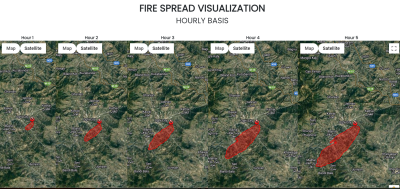
A visual representation of the fire spread over a five-hour period. The images show the changing patterns and extent of the fire, providing valuable insights for forest managers and responders.

LUMS and WWF Team on Site Selection Visit: Collaborating with KPK Forest Department to choose suitable locations for forest fire detection installations.

Team at Work: LUMS technicians setting up the off-grid, solar-powered tower deployment at Shinkiar for forest fire early detection.
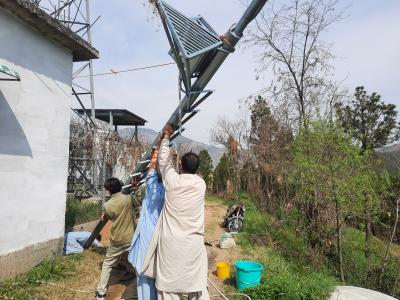
Initial Deployment at Oghi: Engineers setting up solar panels and communication equipment as part of the early deployments for the forest fire detection system.
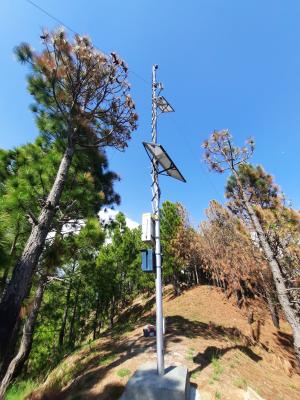
Off-Grid Tower at Shinkiar: This solar-powered installation operates independently without any grid or existing infrastructure, enhancing forest fire detection in unmonitored public forest land.

Field trials at LUMS Digital Sustainable Agriculture Facility: Multiple PTZ cameras and IoT sensors being simultaneously deployed to test the Minimum Viable Product (MVP)
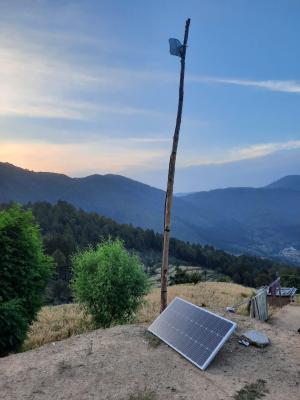
Extending Connectivity: Using a WiFi range extender to ensure communication at a tower site beyond cellular network coverage for effective forest fire detection.
IMPACT STORY
Impacting lifes
The forests of KPK, Pakistan, are among the most vital in the country, but they face an ever-growing threat from forest fires. The changing climate and unsustainable practices have heightened these risks, rendering traditional methods of fire detection and response insufficient and often leading to devastating losses. A recent tragedy highlighted this problem: Muhammad Ishaq’s family from Balakot, KPK, traveling through a forest was engulfed by a wildfire, resulting in the death of their 12-year-old son and severe burns for the rest of the family. The forest department also lost 17 staff members who were responding to forest fire events. In response, WWF-Pakistan reached out to LUMS for further assistance.
Our Forest Fire Detection and Early Warning System (FFD-EWS), developed in collaboration with WWF-Pakistan and the KPK Forest Department, represents a transformative advancement. This system integrates AI-powered real-time IoT cameras, remote sensing, and predictive modeling to create a cost-effective and scalable solution tailored to Pakistan's infrastructure. The FFD-EWS addresses multiple stages of disaster response: preparedness, alertness, and response. It provides timely alerts, supports effective preparation through fire risk maps, and enhances response capabilities with modules for fire spread prediction and route planning.
The project helps build government agencies’ capacity, bridges knowledge gaps with modern technology, and paves the way for data-driven policymaking. Through this innovative approach, we enhanced forest management safety and effectiveness while empowering local communities, demonstrating how interdisciplinary collaboration and cutting-edge technology can safeguard our natural resources, illustrating a path forward for sustainable and resilient forest management in Pakistan. To date, the project has detected and stopped more than 20 forest fires across 600 sq kilometers estimated to have saved hundreds of lives and mitigated damage to the local ecosystem.
LEARNINGS
Lessons learned
Our journey with the Forest Fire Detection and Early Warning System (FFD-EWS) has been both enlightening and instructive. One of the most foremost lessons we learned is the importance of interdisciplinary collaboration. Integrating expertise from AI, remote sensing, computer vision, and IoT allowed us to create a comprehensive solution addressing various stages of disaster response.
Adaptability proved essential throughout this project. We initially faced challenges with data scarcity for training our AI models but improved accuracy by using simulated data and continuously incorporating real-world inputs. Community engagement was another vital component of our success. Involving local communities ensured the system’s sustainability and allowed us to tailor the technology to local needs, enhancing its effectiveness and scalability.
Designing the system with scalability and interoperability in mind was a significant advantage. Utilising cost-effective, locally available components allowed us to scale the solution, maintain it with local resources, while interoperability helped drive down costs by leveraging a broad ecosystem of products.
Building capacity within government agencies was also critical. Introducing modern innovations and providing training to the KPK Forest Department enhanced their ability to adopt innovative technologies and supported need-driven research and technology development. Testing the system in off-grid and harsh environments highlighted the necessity for robust and reliable technology, emphasising the importance of real-world validation before full-scale adoption.
For those embarking on a similar path, fostering interdisciplinary teams and encouraging cross-field collaboration is essential. Embrace adaptability to navigate new challenges, engage stakeholders early to ensure practicality and acceptance, design scalable and cost-effective solutions, and invest in continuous capacity building for long-term success.
FUTURE PLANS
What's coming?
Our future plans for the Forest Fire Detection and Early Warning System (FFD-EWS) aim to broaden the scope and impact of our technology. We are focused on engaging industrial and governmental stakeholders to scale up and adapt the system. This includes leveraging private sector funding and infrastructure, such as using telecom towers as AI-powered fire detection points, to expand our reach and effectiveness.
Our immediate next steps involve launching pilot projects in new high-risk areas, securing funding from diverse sources, and continuously improving our technology. We will also prioritise training and capacity building for local communities and government agencies to ensure they are well-equipped to use and maintain the system effectively.
We plan to integrate more advanced sensors, AI, and remote sensing technologies to address socio-ecological conflicts arising from increased human consumption and growth. These innovations will provide the government and local authorities with better data-driven insights, facilitating sustainable management of natural resources.
We also aim to expand the scope of our early warning system to address other climate change vulnerabilities. According to the Global Climate Risk Index, Pakistan is the 8th most vulnerable nation to the climate crisis with the example of flash floods in August 2022 that affected over 33 million people, half of them children. By integrating scalable technologies, we plan to tackle issues such as flash floods, landslides, and deforestation monitoring. Our system will further support biodiversity monitoring and help prevent human-wildlife conflicts. This holistic approach will provide comprehensive environmental management and protection.

